#gian galeazzo sforza
Text
obsessed when historical fiction straight up lies about real existing people like...not even make up things just lie to the audience. i'm having a really good time with the borgias <3
#me (read 5 books about ressainance homosexuality): thats NOT how gian galeazzo sforza lived 🤨🤨🤨☝🏻#im sure there have been another 100 details that contradict history and i hate this is the first blatant one i noticed 😭 sorry for studying#anyway its so fascinating why did they do that...its such an exaggerrated lie its so funny#a#i always fuck up writing rinascimento stupid ass language with 100 extra letters. kya
2 notes
·
View notes
Photo
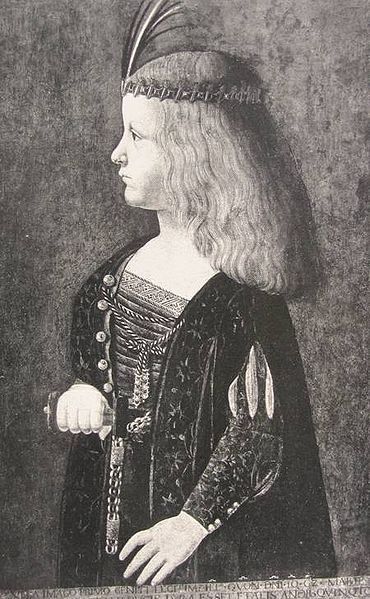
Francesco Sforza Count of Pavia known as il Duchetto, son of Gian Galeazzo and Isabella of Naples, 1501.
20 notes
·
View notes
Text
Happy Three King Day!
Many Christmas carols make mention of the three kings, who follow a star and come to pay homage to the baby Jesus in Bethlehem. They are called “The Three Wise Men from the East.” At many courts in the east, including ancient Babylon and Persia, learned astrologers often served as priestly advisers and practised the art of magic.
In the centuries since the three magi have been interpreted as kings. Through the centuries, paintings have shown as many as eight kings. The Western tradition of three kings most likely arose from three gifts of gold, frankincense, and myrrh that they brought to the 'newborn King.'
Every year, on January 6th, a solemn procession inspired by Benozzo Gozzoli's celebrated fresco in the Chapel of the Magi in Palazzo Medici Riccardi winds its way through the ancient streets of the city centre to celebrate the feast which recalls the journey made by the Magi to pay homage to the Infant.

Procession of the Youngest King
or Corteo dei Magi, Benozzo Gozzoli, Palazzo Medici Riccardi, Cappella dei Magi, Corteo con Lorenzo, Piero e Giovanni de' Medici. Florence, Italy.

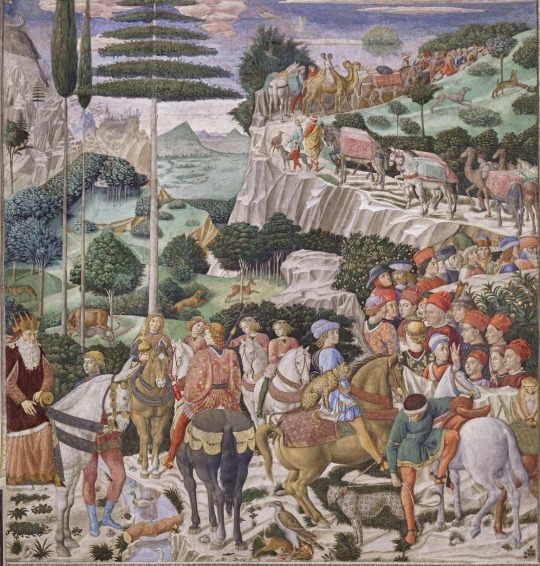
The Chapel of the Magi
The Chapel of the Magi (Cappella dei Magi) is a treasure chest located on the first floor, the heart of the palace. It was designed by Michelozzo and consists of a square-plan space with a recess slightly raised above the floor to accommodate the altar.
It could be accessed via two entrances: a private entrance for the family, and a public entrance for guests. The gilded wooden ceiling, finely carved by Pagno di Lapo, seems to reflect on the precious floor in polychrome marble.

The walls were frescoed by Benozzo Gozzoli from 1459 onwards: the images depict the journey of the Magi towards Christ Child, who is in the foreground of the altarpiece painted by artists belonging to Filippo Lippi’s workshop. Starting from the wall to the east, the parade is headed by Caspar (in a white tunic), the youngest Magus Caspar (possibly a idealised young Lorenzo il Magnifico) at East wall at the Magi followed by Balthazar (in a green tunic) on the south wall, and by Melchior (in a red tunic) on the wall to the west.
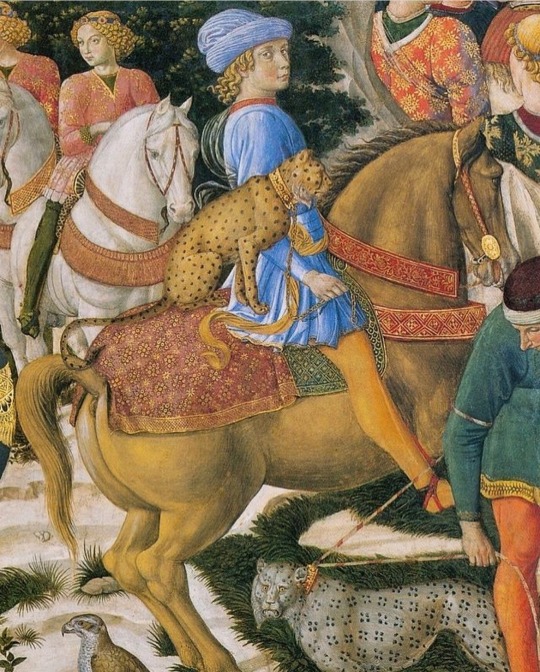
The astonishing richness of details and ornaments is complemented by an accurate depiction of the landscape and characters of the time who join the holy parade: You will notice Cosimo and Piero de Medici, the young Lorenzo and Giuliano, Gian Galeazzo Sforza, Sigismondo Pandolfo Malatesta, and Pope Pius II (born Enea Silvio Piccolomini).
The procession inspired by Benozzo Gozzoli is an event instituted to tie in with the celebrations for the seventh centenary of the laying of the cathedral's foundation stone and the foundation of the Opera itself, reviving an ancient and glorious Florentine tradition from the 15thcentury by staging a historical cavalcade under the auspices of the Archdiocese and Cathedral Chapter in conjunction with the city authorities and with the participation of towns and villages in the province of Florence.
#remagi #ThreeKingDay #benozzogozzolichapel #benozzogozzoli #palazzomediciriccardi #florence #Italy #palazzomediciriccardiflorence #epiphany #Medici #tuscany #renaissanceart
4 notes
·
View notes
Text

Milano - Palazzo Morandi - Arrivo trionfale del corteo del Principe Eugenio di Savoia a Milano in piazza Duomo - 1710
Nel 1499 il Duca di Milano Ludovico il Moro, che aveva usurpato il trono al nipote Gian Galeazzo Sforza, viene esautorato dal Re di Francia Luigi XII che scende in Italia per rivendicarlo.
Da allora Francesi e Spagnoli si contendono il Ducato (l’assedio di Pavia è del 1525) fino alla Pace di Cateau-Cambresis del 1559 (la “Pax Hispanica”) che inizia il dominio spagnolo su Milano fino al 1706 quando Eugenio di Savoia entra trionfalmente in città per occuparla in nome degli Asburgo d’Austria.
Le tappe fondamentali di questo periodo sono:
- 1560 - Mura spagnole
- 1563 - Carlo Borromeo Arcivescovo di Milano
- 1579 - Carlo Borromeo fonda il Collegio Elvetico in via Senato e consacra San Fedele per accogliervi i gesuiti a cui furono dati i beni sequestrati al soppresso Ordine degli Umiliati, vicino al Calvinismo
- 1595 - Federico Borromeo Arcivescovo di Milano
- 1609 - Forte di Fuentes a Colico. Federico Borromeo inaugura la Biblioteca Ambrosiana
- 1626 - Sant’Alessandro in Zebedia
- 1630 - San Giuseppe (Francesco Maria Richini). Peste manzoniana
- 1654 - Sant’Antonio Abate
- 1692 - Santa Maria della Passione
- 1706 - In seguito alla guerra di successione spagnola, Eugenio di Savoia conquista il Ducato ed inizia il dominio austriaco e il relativo gusto architettonico
0 notes
Text
I LUOGHI DELL'ANIMA

Era inevitabile: Assisi è il luogo della pace per eccellenza in Italia.
Incastonato tra le dolci colline umbre, la storia e le tradizioni del paese in provincia di Perugia, è meta da tempo immemore di pellegrinaggi in ricordo di San Francesco.
Ma esploriamo l'ameno centro attraverso il portale
https://www.visit-assisi.it

Assisi è una città di origine Romana (con il nome di Asisium), ne sono testimonianza numerosi monumenti come la facciata del Tempio di Minerva, l’Anfiteatro, le Mura, il Foro.
Con la caduta dell’Impero Romano la città divenne un insediamento prima dei Goti (545) e poi cadde sotto il dominio dei Longobardi.
Con il medioevo divenne comune indipendente e conobbe uno sviluppo straordinario sopratutto grazie ai movimenti monastici (in special modo i Benedettini).
Il più illustre dei suoi cittadini San Francesco nacque nel 1182. Francesco
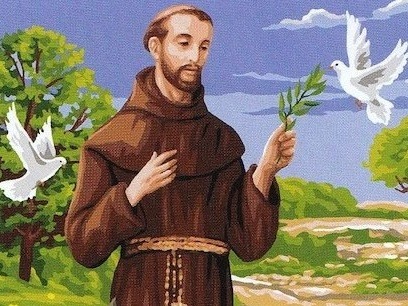
viene proclamato santo nel 1228, due soli anni dopo la sua morte, da Papa Gregorio IX.
Più tardi la Città fu sotto la mano delle signorie come quella di Gian Galeazzo Visconti, della famiglia dei Montefeltro, di Braccio Fortebraccio e di Francesco Sforza, fino alla meta’ del sedicesimo secolo, quando l’Umbria fu conquistata da Papa Paolo III ristabilendo il controllo papale sulla città.
Più tardi, nel diciannovesimo secolo, la città divenne parte del nascente stato italiano.
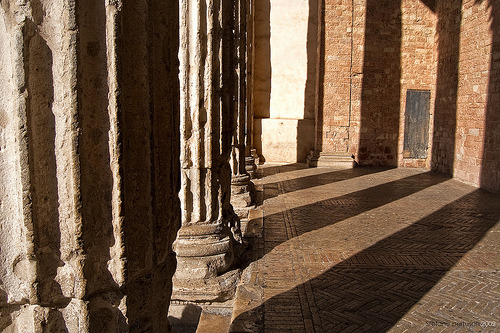
Assisi, a partire dal III secolo a.C. intrattenne le prime relazioni diplomatiche con Roma.
Venne stipulato un trattato che la impegnava a collaborare, fornendo contingenti militari. Nel 90 a.C. divenne municipio romano. Parte del territorio, dopo il 41 a.C. venne confiscato e assegnato alla vicina Spello.
Negli stessi anni Assisi diede i natali a Properzio, uno dei massimi poeti elegiaci del tempo.
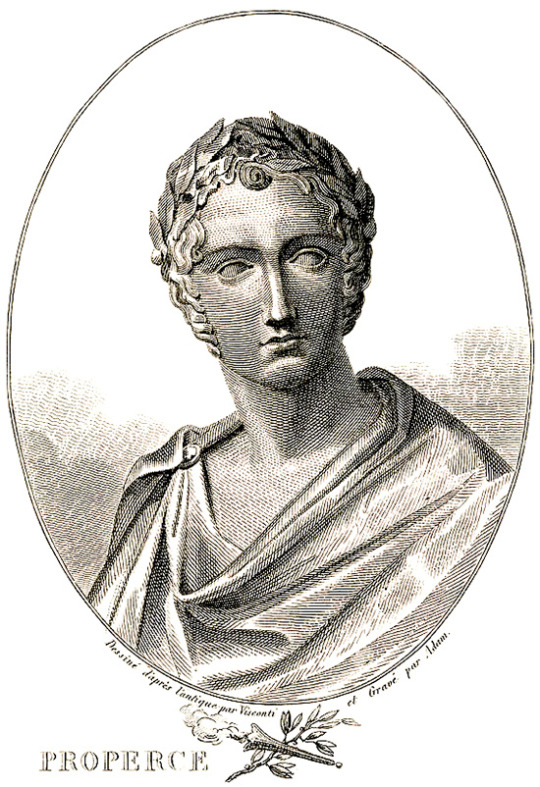
La collezione archeologica pertinente al municipio si trova nel Museo del Foro Romano, in parte ospitato nella cripta di San Nicolò, ma che si estende sulla superficie sotto la piazza, fino a giungere in una sala in cui è visibile il lastricato della zona meridionale dell’antico foro.
Assisi visse in prosperità sino alla caduta dell’impero romano. Ne sono testimonianza, oltre al Foro romano, il Tempio di Minerva, l’Anfiteatro (posto nella parte alta della Città) e le Domus ritrovate (Domus romana di Palazzo Giampè e Casa romana detta di Properzio).

Assisi conobbe il suo maggiore periodo di splendore tra il XII ed il XIII secolo quando fu libero comune.
Agli albori dell’anno mille, sostenne lotte molto dure con la vicina Perugia, comune guelfo, con la quale infine pattuì una lunga pace. Risale a questo periodo (1182) la nascita di San Francesco che tanto influirà sulla vita della stessa città, non soltanto dal punto di vista strettamente religioso, ma anche e soprattutto dal punto di vista culturale e artistico. Alla figura di San Francesco è legato lo sviluppo artistico della città. Nel XIII secolo sorsero le basiliche dedicate a lui e a Santa Chiara, la cui costruzione e decorazione richiamò i principali artisti italiani del ’200 e ’300.
Si innalzano i Palazzi del Capitano del Popolo
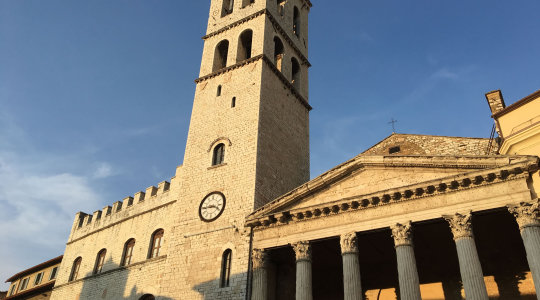
e del Monte Frumentario ed anche alcune porte. Nella pittura operano, oltre a Cimabue e Giotto, il Maestro di San Francesco e quello di Santa Chiara, Pisano e Lorenzetti.
Il regime feudale mal si conciliava con le pulsioni delle classi emergenti che nel 1198, dopo aver dato vita al libero Comune, rasero al suolo la Rocca Maggiore, sede dell’oppressore duca Corrado di Lutzen, potente fiduciario di Federico Barbarossa. In questo clima, fatto di stridenti contraddizioni, nasce Francesco di Bernardone. Il 16 luglio 1228 Gregorio IX giunge ad Assisi per proclamare santo Francesco; il giorno dopo benedice la prima pietra e si avviano i lavori della Basilica e del Sacro Convento: monumenti insigni che segneranno per sempre lo sviluppo edilizio e storico della città di Assisi.
A partire dal XIV secolo la prosperità di Assisi, soggetta a Perugia, cominciò a declinare sino a quando nel Quattrocento divenne parte dello Stato Pontificio.
Dopo un certo periodo di tranquillità conseguente alla pace con Perugia, Assisi, durante il rinascimento fu governata da diverse signorie il cui dominio fu caratterizzato da cruenti lotte con le città vicine, a seguito delle quali subì diversi terribili saccheggi e devastazioni.

In campo artistico lo stesso rinascimento vede ancora sorgere palazzi, fontane e, in campo pittorico, le opere più significative sono da additare nella costruzione della Basilica di Santa Maria degli Angeli.
Altri cenno storici e suggerimenti potrete consultarli ai vari sottolink di "visit-assisi", come:
https://www.visit-assisi.it/storia-e-cultura-2/storia/assisi-medioevale/
0 notes
Text
PARCIAL II
Primera Fase
Para la primera parte del parcial, mi compañero Diego Rosales y yo nos encargamos de investigar respecto al arquitecto del que se está hablando en el texto de Manfredo Tafuri, Donato Bramante. En mi caso, investigué sobre sus más destacables obras:
· Templete de San Pietro in Montorio:
Alto Renacimiento. En uno de los patios del convento franciscano homónimo en Roma, actual Academia de España en Roma, Italia. 1502. financiada por los reyes católicos, Isabel de Castilla y Fernando de Aragón, como monumento conmemorativo del martirio de San pedro.
· Chiesa di Santa Maria presso San Satiro:
Renacentista, neorrenacentista (fachada), románico (campanario). Iglesia parroquial de Via Torino, Milán, Italia. 1482. Su construcción fue emprendida a finales del siglo xv por voluntad del duque Gian Galeazzo Sforza y más tarde continuada por Ludovico el Moro como parte de un ambicioso programa de renovación del arte en el ducado.
· Basílica de San Pedro:
Arquitectura del Renacimiento, Arquitectura barroca. Piazza San Pietro, Ciudad del Vaticano. 18 de noviembre de 1626 (inauguración). Templo católico. Cuenta con el mayor espacio interior de una iglesia cristiana en el mundo.
· Santa Maria delle Grazie:
Arquitectura gótica, Arquitectura del Renacimiento. Iglesia y convento de la Orden de Predicadores en la Piazza di Santa Maria delle Grazie, Milán, Lombardía, Italia. 1497. Arquitectos: Donato d'Angelo Bramante, Guiniforte Solari, Giovanni Antonio Amadeo. El refectorio del convento está decorado con la célebre pintura mural La última cena, obra maestra de Leonardo da Vinci.
· Chiostro del Bramante:
Renacimiento italiano. Edificio renacentista italiano en Arco della Pace, Roma. 1504. Encargado por el cardenal Oliviero Carafa alrededor de 1500. Se inspira en el clasicismo, eliminando las decoraciones extra en favor de los elementos estructurales.
· Catedral de Milán:
Arquitectura gótica y neogótica, Arquitectura del Renacimiento. Catedral gótica emplazada en la ciudad homónima, P.za del Duomo, Milano MI, Italia. 6 de enero de 1965 (inauguración). Es la sede episcopal de la Archidiócesis de Milán. Dedicada a Santa María Nascente. Es uno de los edificios más famosos y complejos del mundo, mezcla del gótico tardío, gótico francés y renacentista.
· Palacio Apostólico:
Arquitectura del Renacimiento. Residencia oficial del papa en la Ciudad del Vaticano, Ciudad del Vaticano. 30 de abril de 1589 (inauguración). Complejo de edificios, comprendiendo los Apartamentos Papales, las oficinas de gobierno de la Iglesia católica, un puñado de capillas, los Museos Vaticanos y la Biblioteca Vaticana.
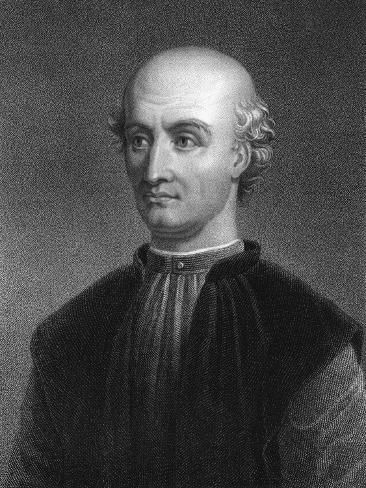
Camila Villalba | Historia de la Arquitectura II | Prof. Rebeca Tineo
@lonuevodenuevo
1 note
·
View note
Text
Lombard Renaissance Art
A visit to the Certosa of Pavia, which sums up all the aims and achievements of Lombard Renaissance art, is necessary for an appreciation of the Milanese sculptors and painters, while the associations of the famous building with Gian Galeazzo Visconte and with the Sforza princes, make it a part of Milanese story. The old Church of Chiaravalle, with its incomparable Lombard - Gothic tower and its trecento frescoes, and picturesque Monza, where that historic emblem and wonder of twelfth century goldsmiths’ art, the Iron Crown of Lombardy, is preserved with other priceless treasures, ought not to be missed by the traveler.
#20 (p.xiv)
Noyes, Ella. The Story of Milan. London: J. M. Dent & sons, ltd., 1926.
https://catalog.hathitrust.org/Record/000376770/Cite
0 notes
Text
Visit Milan: What to See and Do

Visit Milan. What to see and do. We will admit when we were wrong or when situations change. I have probably visited Milan about 20 times in my life, most times only visiting the Duomo and taking a train to other parts of Italy. I had some friends that lived in Milan and stayed for a bit, but even still, Milan was not a tourist destination in my mind. Reconsidering the city, I find that Milan is indeed an interesting city and worthy of exploration. It delivers whether you are looking for art, history, sport or just a good time out at a great restaurant or club. If you have ever wondered what to do in Milan, here are some must-do things to make your stay in Milan unforgettable.
Visit the Duomo of Milan and Its Museum
Let's start this list of must-sees in Milan with its flagship monument, the emblem of the city, the Duomo. The Duomo is the cathedral of Milan, located in Duomo square in the center of Milan. For the record, the cathedral was built in 1386 by Gian Galeazzo Visconti in the place of two old churches that were destroyed to make way for the cathedral. The remains of these churches are still visible under the cathedral and one can see them during a visit to the cathedral. The Duomo of Milan has dizzying dimensions, is the third largest in the world with 12,000m² of surface area and can accommodate more than 40,000 people. The cathedral is richly decorated with magnificent stained-glass windows as well as a large number of statues (about 3400).
In addition to it, the terraces of the cathedral are also worth seeing. Climb the roof via the stairs or the elevator and get a closer look at the gargoyles or other sculptures on the roof. On top of that, you can enjoy a breathtaking view of Milan and its surroundings.
The third stage of the visit to the cathedral is its museum. Located on the right of the cathedral, when looking at it from the square, the Duomo Museum retraces its history and exhibits many pieces: sculptures, paintings, stained glass windows, gargoyles and a model.
Visit La Scala
Let's continue now with another monument to visit in Milan: The La Scala theatre. The construction of this theatre began in 1776. Its name, Alla Scala, is due to the location chosen for its construction. It is also built on the site of an old church from the XIVth century. This church bore the name of its creator: Beatrice Regina Della Scala. It is, therefore, a tribute to this monument which was destroyed to make way for this magnificent performance hall.
La Scala is located in Piazza Della Scala. Despite a very sober exterior, you will have to go inside to become aware of the grandeur of the place and its beauty. The tour begins with a visit to the La Scala Museum. It retraces the history of the theatre and the main characters who passed through La Scala during their career. Among other things, you can admire a room presenting the portraits of many celebrities who have marked La Scala, such as Maria Callas and Renata Tebaldi, the two most famous singers here.
The rest of the visit continues with the reception room, which is dazzling by its decoration. But the most awaited moment is to be able to access the dressing rooms of the theatre to admire the splendid performance hall. The dressing rooms are all carpeted in red and give a pleasant, subdued atmosphere. As for the hall, it is grand and easy to imagine the greatest operas being held here. The decorations are taken care of down to the smallest detail.
Parcourir the Vittorio Emanuele II Gallery
The Vittorio Emanuele II galleries, located between Duomo Square and La Scala Square, are among the must-sees to visit in Milan. These galleries are among the most beautiful in the world!
These galleries are in the shape of a cross and measure 14.5 m wide for 105 m long for the shortest axis and 196 m for the longest axis. The Vittorio Emanuele II galleries now house many luxury boutiques, such as Prada or Armani, and some restaurants.
Visit Sforza Castle
Built around the 1360s by Galéas II Visconti, the Sforza Castle, originally a fortress, is one of the monuments not to be missed in Milan. Almost a century after its construction and after the death of Galéas II Visconti, the Ambrosian Republic decided to destroy the fortress. It is on these ruins that the castle was built by Francesco Sforza, Duke of Milan.
First used as a ducal residence, then as a fortress with the addition of new fortifications during the Spanish occupation, the castle was, a few centuries later, doomed to destruction under the Napoleonic occupation. The destruction, which began with the demolition in 1801 was stopped against the will of the Milanese, who wanted the construction of a new residential district.
The castle has been damaged several times over the centuries, especially during the Second World War and was renovated again. It was in 2005 that the last restoration work was completed.
Visit the Ambrosian Pinacoteca
Let's continue this article with a second art gallery to visit in Milan, which is also remarkable. This is the Ambrosian Pinacoteca. Just like the previous art gallery, this one also occupies a building steeped in history. The Ambrosian Palace was commissioned in 1603 by a Milanese cardinal to create a cultural project. It is open to all and above all, free. In this project, the cardinal integrates a library, which is the first in the world to be open to the public. A few years later, this same cardinal decided to exhibit his personal collection of works of art and opened the first museum in Italy. Over the years, the collection has been enriched. It is now considered one of the most beautiful private collections in Italy.
During the visit to this art gallery, you can admire both the works and the interior of the different rooms, from floor to ceiling. Remarkable paintings are exhibited, such as the Portrait of a Musician by Da Vinci or the Fruit Basket by Caravaggio.
Visit the Stade Giuseppe Meazza – San Siro
Now let's move on to a must-visit for all football fans, a visit to Milan's iconic stadium, the Giuseppe Meazza stadium, better known as the San Siro.
Let's start by clearing up this last point regarding the name of the stadium. Since 1980, this has been called the Giuseppe Meazza stadium, named after an illustrious Italian footballer who played for the two clubs in the city and has won two World Cups with Italy. The name San Siro comes from the neighborhoods in which the stadium is located.
The Milan stadium has a rare feature in Europe. The stadium is home to the city's two clubs: AC Milan and Inter Milan. Two clubs which play at the highest level have each won several Italian titles and European cups. When visiting the stadium, this peculiarity will strike you. Each of the two teams has its own dressing room. In addition to the visitors' changing rooms, this brings the number of changing rooms to 3!
Each of the two teams has half of the field, and the supporters have their separate stands. Similarly, the stadium museum, like the shop, is divided into two parts, one for AC Milan and the other for Inter. During the tour, you will learn about the history of the stadium, its many renovations, expansions and the history of these two historic clubs.
For the record, the stadium first belonged to AC Milan before the city bought it and then, a few years later, decided to also place Inter Milan there.
Our Final Word
If you explore Milan, you will not be disappointed. With art, history, architecture, shopping and great restaurants, Milan has become a destination rather than just a stopping point. Next time you are in Itay, consider a couple of days in Milan. You will love it.
Related Posts
Read the full article
0 notes
Photo

Marco d'Oggiono - Portrait of a Young Man as Saint Sebastian1485 - 1489
#art#renaissance#marco d'oggiono#the portrait of a young man#portrait#saint sebastian#gian galeazzo sforza#sforza#youth#young man#arrow
47 notes
·
View notes
Photo

Giovanni Ambrogio de Predis: Retrato de Gian Galeazzo Sforza (hacia 1483).
26 notes
·
View notes
Photo

Bona Sforza, Queen of Poland (2 February 1494 - 19 November 1557)
#bona sforza#queen of poland#daughter of gian galeazzo sforza#wife of sigismund i of poland#history#women in history#poland
2 notes
·
View notes
Photo

Milano - Santo Stefano - Lapide commemorativa dell’assassinio del Duca Galeazzo Maria Sforza - XVIII sec.
Nel 1441 il Duca di Milano Filippo Maria Visconti dà in sposa la figlia Bianca Maria al condottiero Francesco Sforza che aveva fronteggiato nel conflitto con Venezia per poi morire nel 1450. Dopo tre anni di repubblica ambrosiana, Francesco Sforza riesce a farsi Duca ed inizia a ricostruire il Castello di Porta Giovia e ad edificare la Ca’ Granda.
Il figlio Galeazzo Maria, divenuto Duca nel 1466 alla morte del padre, sposò Bona di Savoia, ma venne assassinato nella Chiesa di Santo Stefano nel 1476.
Gli successe Gian Galeazzo con la reggenza della madre e fu supportato dal segretario Cicco Simonetta finchè lo zio, Ludovico il Moro prese il potere e sposò Beatrice d’Este nel 1491, ma fu scacciato dai francesi che erano scesi a Napoli nel 1494 con Carlo VIII e con Luigi XII nel 1500 e Milano resto in mano agli stranieri per più di quattro secoli.
5 notes
·
View notes
Photo


The daughter of Duke Gian Galeazzo Sforza of Milan and Isabella of the Neapolitan Aragons, Bona was represented as intelligent, beautiful, resolute, and exemplifying the virtues of the Renaissance education provided by her parents. According to the description by the Polish ambassadors sent to Naples to contract the marriage, Bona 'has the most beautiful golden hair, and at the same time black eyebrows and eyelashes, her eyes are more angelic than human, […] her cheeks rosy, as though decorated with a natural blush of timidity.' Then they turned to praising her education: 'We heard her speaking Latin without a preparation beforehand, and we take God as our witness that she said nothing that would not be eloquent either with regards to metaphor or speaking in the most elegant manner.’
- Carey Fleiner and Elena Woodacre, Virtuous or Villainess? The Image of the Royal Mother from the Early Medieval to the Early Modern Era
317 notes
·
View notes
Text
Famiglia Lotteringhi Della Stufa


Sembra che il capostipite di questa famiglia, sia un Lottario o Lottaringo, sceso in Italia nell’anno 998 al seguito dell’Imperatore Ottone III di Sassonia, re dei Franchi Orientali. I Lotteringhi nel 1200 abitavano nei pressi di una “stufa” (antiche terme romane di Firenze). L’appellativo “stufa” venne aggiunto in seguito al cognome; Lotteringhi della Stufa.
Furono iscritti nell’Arte dei lanaioli “del Garbo” l’Arte della Lana dal XIII secolo e in seguito dei setaioli. Un appartenente alla famiglia: Cambio della Stufa fu combattente a Montaperti, nella sfortunata battaglia che si svolse sulle rive del fiume Arbia, nelle file dei Guelfi fiorentini contro i Ghibellini Senesi. Da suo figlio Lotteringo, nacque Ugo Giureconsulto. Un altro Ugo figlio di Lotto assalì i palazzi dei magnati nel 1343 al tempo della cacciata del tiranno Gualtieri di Brienne, riuscendo in seguito con il loro aiuto a cacciarli dalla città.
Giovenco di Ugo giurisperito (esperto di diritto, giurista, giureconsulto), difese la Signoria dall’assalto dei Ciompi. Ricevette come ricompensa per il suo intervento il “Cingolo di cavaliere” (cintura di cuoio o di stoffa annodata o chiusa con una fibbia sul davanti), nel 1381. Contribuì alla conclusione della pace fra le città di Pistoia e Lucca. Suo fratello Andrea partecipò nel 1384 alla compra della città di Arezzo da Carlo di Durazzo. Prese parte alle trattative con la Repubblica di Venezia a difesa dei Carraresi, alla guerra contro Gian Galeazzo Visconti del 1398. Nell’anno 1406 prese parte all’organizzazione del dominio di Firenze su Pisa. Ugo figlio di Giovenco fu molto amico dei pisani, che lo vollero come loro Podestà. Nel 1409 si recò da Ferdinando di Napoli e ne divenne un ascoltato consigliere, morì nel 1480. Angelo di Lorenzo fu persona molto influente nel XV secolo, ricevette incarichi delicati dalla Repubblica Fiorentina: ambasceria presso il duca di Milano Galeazzo Maria Sforza, dal quale venne insignito del titolo di cavaliere "spron d’oro".

Suo figlio Luigi fu intimo della famiglia medici, legato a loro da vincoli di parentela matrimoniale. Dopo la congiura dei Pazzi con l’uccisione di Giuliano, fece parte del gruppo di cittadini, impegnati nella protezione di Lorenzo. Si iscrisse giovanissimo all’Arte della Lana, iniziando nel contempo la carriera politica, emergendo nell’attività diplomatica. Nell’anno 1486, il Magnifico Lorenzo mandò in Egitto Paolo da Colle, per avviare relazioni economiche fra le due città. Alla morte di Paolo da Colle, il Sultano Mamelucco d’Egitto Qa’it Bey (nome completo arabo Saif Al-Din Qaytbay Al-Mahmud Al-Asharafi Al-Zamiri), volle continuare le trattative, inviando a Firenze un suo ambasciatore, per sottoporre alla Signoria una bozza di accordo commerciale. Con l’accettazione dei capitoli dell’accordo commerciale, il Della Stufa venne inviato in Egitto, per informare al suo ritorno i Consoli sull’accordo, portare al Sultano i regali di Lorenzo e della Signoria, ringraziandolo per aver inviato in regalo al Medici un leone e una giraffa.
Un altro appartenente alla famiglia Prinzivalle fu un accanito sostenitore dei Medici, congiurò nel 1510 contro il Gonfaloniere a vita Pier Soderini supposto tiranno. Il complotto fallì per una soffiata ricevuta dalle autorità repubblicane, che attribuirono l’idea della cospirazione al Cardinale Giovanni de Medici. Il piano prevedeva che dopo la morte del Soderini per mano del Della Stufa, Marcantonio colonna al comando di un gruppo di armati, doveva entrare in città per preparare il ritorno di Giovanni. Pandolfo venne protetto in Francia dalla regina Caterina de Medici. Ricevette cariche onorifiche dalla corte francese, ma venne cacciato quando rivelò a Cosimo I° i piani per la guerra di Fiandra. Nella battaglia di Montalcino contro i senesi, ricevette dal duca il comando delle truppe fiorentine.
Il figlio di lui Pandolfo intraprese la carriera ecclesiastica divenendo cappellano maggiore del Granduca Ferdinando II de Medici. Dal quale ricevette nel 1632 il marchesato. La line primogenita si estinse nel 1667, quando Domenico Andrea passò il “fidecommesso” (disposizione testamentaria, per la quale l’erede designato, è obbligato a conservare l’eredità, e passarla tutta o in parte, ad un altro componente della famiglia) a Ugo di Gismondo del ramo di Gismondo di Agnolo.

Alberto Chiarugi
Read the full article
0 notes